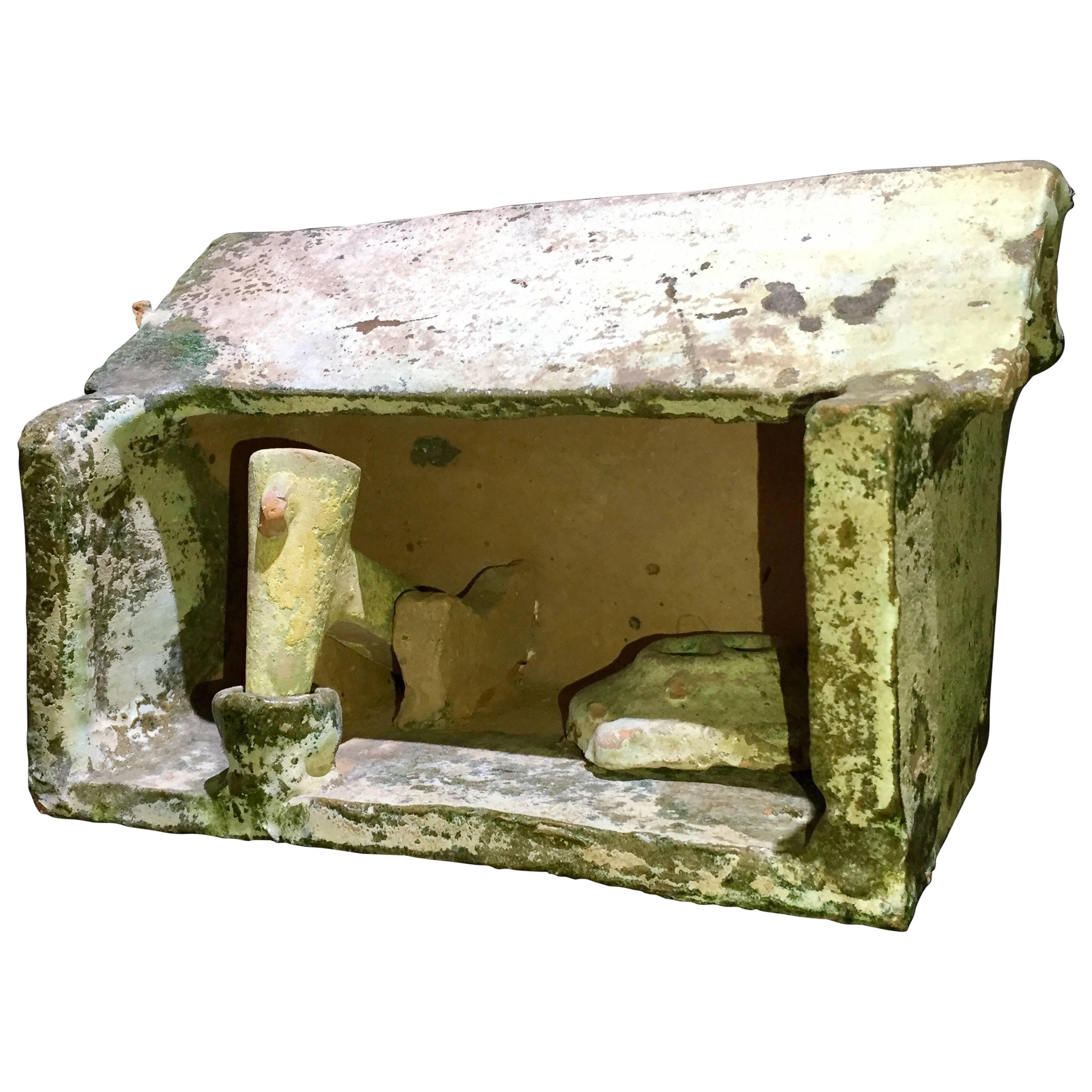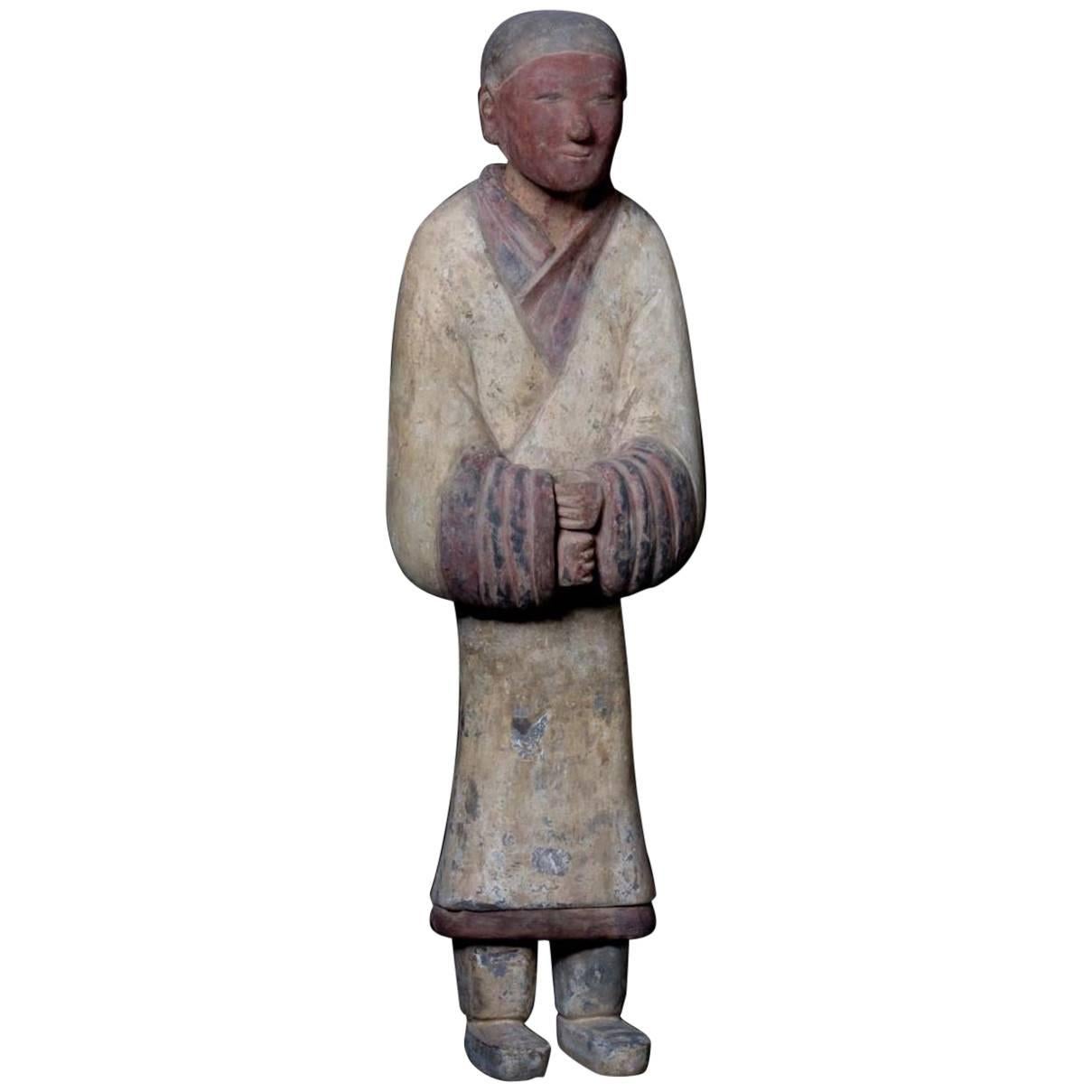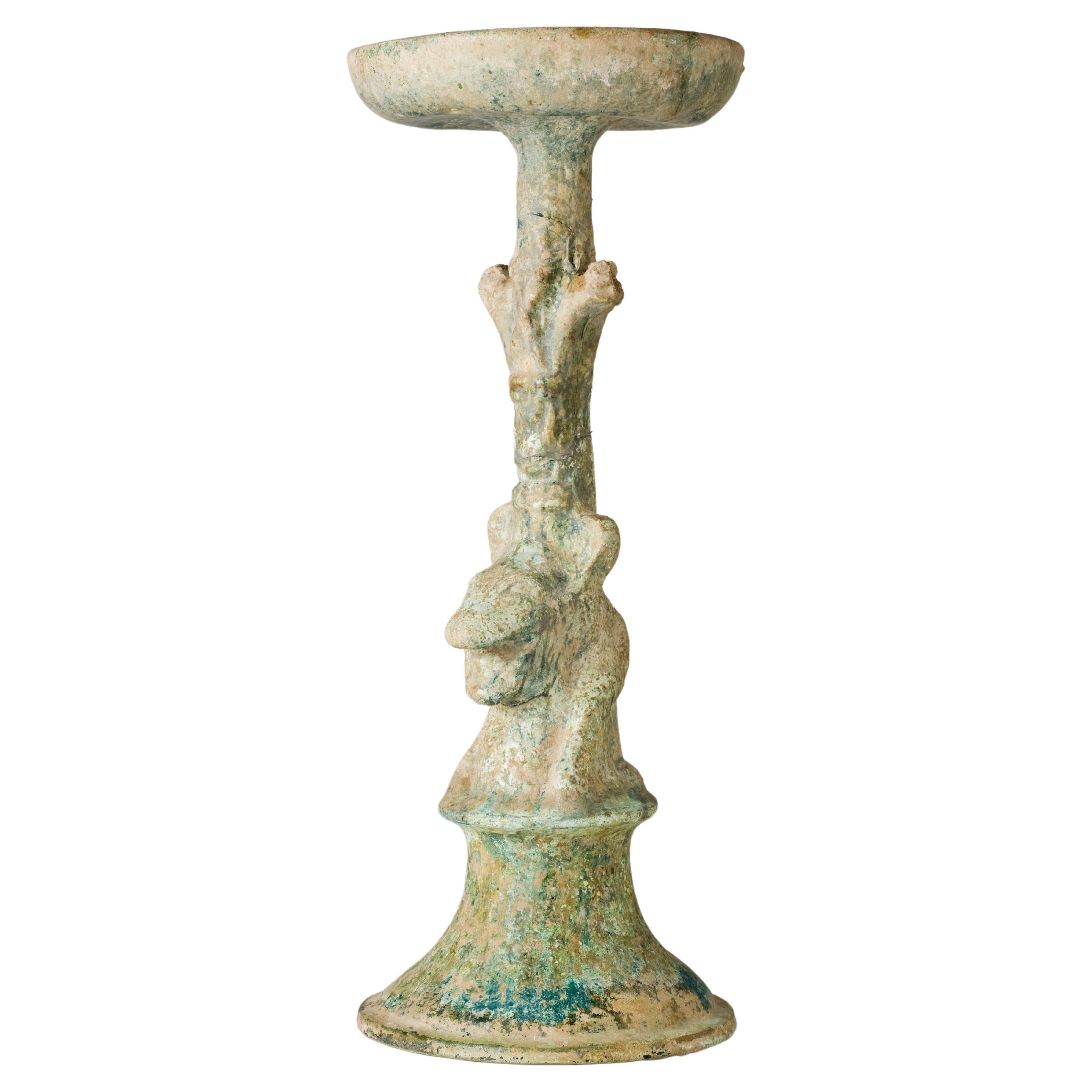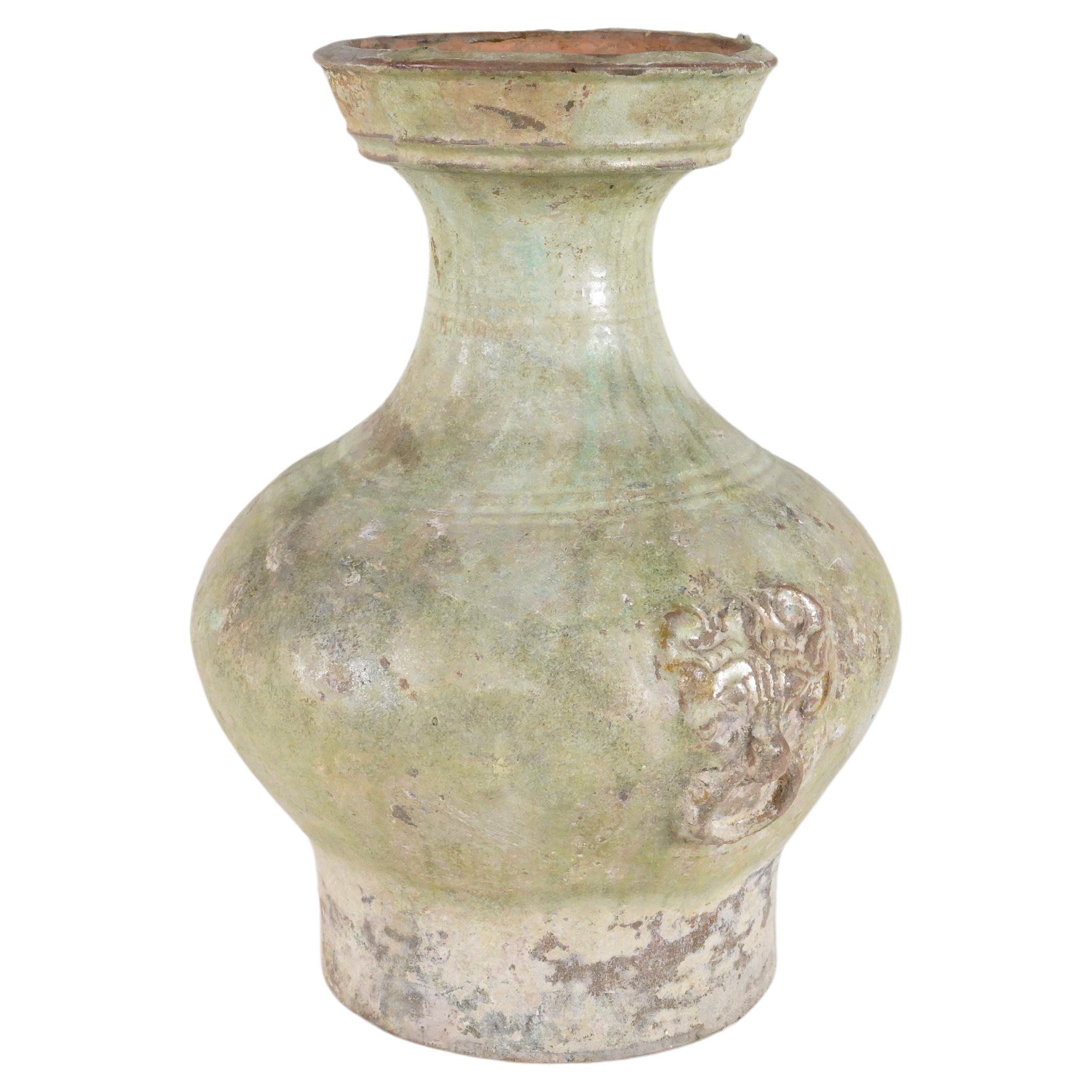Items Similar to Eastern Han Dynasty Terracotta Barn Workshop, China '206BC - 220AD' Ex-Museum
Want more images or videos?
Request additional images or videos from the seller
1 of 9
Eastern Han Dynasty Terracotta Barn Workshop, China '206BC - 220AD' Ex-Museum
About the Item
Slab pottery constructed barn workshop having a peaked roof – open walled form with a mechanical pounder and a large round covered storage container. Light blue-green mottled glazed surface with some iridescence patina to the glaze.
Condition: Intact, excellent condition, an unusual example.
Provenance: The Living Torah Museum, Brooklyn; ex. Sands of Time, 2002.
Sculptural effigies of domesticated animals were often interred in the tombs of nobility and elite members of the social hierarchy. Models like this one were made to represent everything from simple goat or pig pens to the most elaborate towers and palaces. Because very few ancient Chinese buildings have survived intact, these models, along with descriptions from ancient texts, give a good representation of what the buildings might have looked like.
This fantastic piece is accompanied by a Certificate of Authenticity.
Burial figurines of graceful dancers, mystical beasts, and everyday objects reveal both how people in early China approached death and how they lived. Since people viewed the afterlife as an extension of worldly life, these figurines, called mingqi, sometimes referred as “spirit utensils” or “vessels of ghosts” disclose details of routine existence and provide insights into belief systems over a thousand-year period. For the first time in Chinese history, we have images of rural and daily life during the Han in the form of contemporary records, numerous ceramic burial items and stone monuments. There is a rich array of hunting scenes, barnyard animals, houses, watchtowers, soldiers, entertainers, even kitchen stoves. Behind the proliferation of grave goods lay a belief in the depiction of both the real world and evolving concepts of heavenly realms and celestial beings.
Ultimately, funerary objects such as mingqi worked in concert with other funerary objects, tomb architecture, shrines, and spirit-road sculptures to achieve a goal that exceeded the well-being of the family.
According to Confucian doctrine, when every person performed their prescribed social role to perfection, the cosmos would achieve harmony. By ensuring the well-being of the dead, the living promoted accord in the celestial realm and in their own terrestrial existence.
The Han Dynasty is one of the great dynasties in Chinese history, encompassing nearly four hundred years of expansion and consolidation which coincided with the period of the Roman republic and empire in the West. It was the second imperial dynasty of China (206 BC–220 AD), preceded by the Qin dynasty (221–206 BC).
Spanning over four centuries, the Han period is considered a Golden Age in Chinese history. To this day, China's majority ethnic group refers to themselves as the "Han people”.
- Dimensions:Height: 5 in (12.7 cm)Width: 9 in (22.86 cm)Depth: 7.5 in (19.05 cm)
- Style:Han (Of the Period)
- Materials and Techniques:
- Place of Origin:
- Period:
- Date of Manufacture:206 BC - 220 AD
- Condition:Wear consistent with age and use.
- Seller Location:San Pedro Garza Garcia, MX
- Reference Number:
About the Seller
3.7
Vetted Seller
These experienced sellers undergo a comprehensive evaluation by our team of in-house experts.
1stDibs seller since 2017
22 sales on 1stDibs
Typical response time: 18 hours
- ShippingRetrieving quote...Ships From: Laredo, TX
- Return PolicyA return for this item may be initiated within 3 days of delivery.
More From This SellerView All
- Eastern Han Dynasty Terracotta Model of a Paper Mill , China '206BC - 220AD'Located in San Pedro Garza Garcia, Nuevo LeonSlab pottery constructed Model of a Paper Mill, in Green and Cream Color Glazed Terracotta having a peaked roof – open walled form with a mechanical pounder and a large round storage container. Light blue-green mottled glazed surface with some iridescence patina to the glaze. The Iridescence is a refraction of the layers on the glass that produces multicolor hues & metallic luster, and only develops after one thousand years of being buried in the ground. An unquestionable mark of antiquity, impossible to falsify. Han Dynasty, dated 206 B.C-220 A.D. Condition: Excellent, wear commensurate with age, an unusual example. This fantastic piece is accompanied by a Certificate of Authenticity. Sculptural effigies of domesticated animals were often interred in the tombs of nobility and elite members of the social hierarchy. Models like this one were made to represent everything from simple goat or pig pens to the most elaborate towers and palaces. Because very few ancient Chinese buildings have survived intact, these models, along with descriptions from ancient texts, give a good representation of what the buildings might have looked like. Burial figurines of graceful dancers, mystical beasts, and everyday objects reveal both how people in early China approached death and how they lived. Since people viewed the afterlife as an extension of worldly life, these figurines, called mingqi, sometimes referred as “spirit utensils” or “vessels of ghosts” disclose details of routine existence and provide insights into belief systems over a thousand-year period. For the first time in Chinese history, we have images of rural and daily life during the Han in the form of contemporary records...Category
Antique 15th Century and Earlier Chinese Han Antiquities
MaterialsTerracotta
- Elegant Han Dynasty Terracotta Warrior - China '206 BC - 220 AD'Located in San Pedro Garza Garcia, Nuevo LeonImpressive terracotta warrior representing a banner bearer gripping a wooden staff with his hands (dematerialized through the ages); his gaze is ser...Category
Antique 15th Century and Earlier Chinese Han Antiquities
MaterialsTerracotta
- Monumental Han Dynasty Terracotta Horse - TL Tested - China, '206 BC–220 AD'Located in San Pedro Garza Garcia, Nuevo LeonA massive pottery horse with separately made head and tail, standing on all fours and striding with its right hoof forward. Extended snout ends in parted lips showing teeth beneath i...Category
Antique 15th Century and Earlier Chinese Han Antiquities
MaterialsTerracotta
- Chimera (Pixiu) Terracotta Mythological Being - Tang Dynasty, China '618-907 AD'Located in San Pedro Garza Garcia, Nuevo LeonMagnificent Mythological Being "Chimera" with Human Face and Flaming Rays Halo. Orange Terracotta with Traces of Stucco and Painting. This creature is commonly known as Pixiu. Fierc...Category
Antique 15th Century and Earlier Chinese Tang Antiquities
MaterialsTerracotta
- 6 Elegant Ming Dynasty Court Attendants in Glazed Terracotta, China 1368-1644 ADLocated in San Pedro Garza Garcia, Nuevo LeonA fine set of a six court attendants as in the Forbidden City of Beijing, elegantly dressed in a Green & Red Daopao – a traditional men’s formal attire from the Ming Dynasty dated 1368-1643 A.D. – with glazed robes and Red Pigment remains in their hat and belts. They stand in an honorary posture atop a red plinth, some with orifices in their hands, where spirit objects were placed to comfort or satisfy the deceased. The heads are detachable, as often seen on the larger figures from this period. They are accompanied by a Certificate of Authenticity, and Certificate of Expertise by Jean-Yves Nathan - a leading authority specialized in Far East Archaeology from the CEDEA (The European Confederation of Art Experts). Burial figurines of graceful dancers, mystical beasts, and everyday objects reveal both how people in early China approached death and how they lived. Since people viewed the afterlife as an extension of worldly life, these figurines, called mingqi, sometimes referred as “spirit utensils” or “vessels of ghosts” disclose details of routine existence and provide insights into belief systems over a thousand-year period. The Ming dynasty was the ruling dynasty of China – then known as the Empire of the Great Ming – for 276 years (1368–1644 AD). Founded by Chu Yuan-chang, the rebel leader that was successful in removing the mongols from the throne. Chinese control was re-asserted in China and eastern Asia. Literature became more important, schools were created, and the justice system was reformed. The Ming dynasty is described by some as "one of the greatest eras of orderly government and social stability in human history,” was the last imperial dynasty in China ruled by ethnic Han Chinese. The practice of burying ceramic objects with the deceased went into decline from the 10th to the 14th Century AD. There was a revival in placing miniature representations of glazed terracotta objects such a furniture, food offerings, horses, miniature statues...Category
Antique 15th Century and Earlier Chinese Ming Antiquities
MaterialsTerracotta
- Magnificent Court Attendants in Terracotta - Ming Dynasty, China 1368-1644 AD TLLocated in San Pedro Garza Garcia, Nuevo LeonA magnificent pair of male and female courtiers from the Ming Dynasty (1368-1644 CE) in excellent condition. They are wearing traditional Daopao robes in green and black garments wit...Category
Antique 15th Century and Earlier Chinese Ming Antiquities
MaterialsTerracotta
You May Also Like
- Ancient China Monumental Stone Ram Han Dynasty, 206BC-220ADLocated in South Burlington, VTChina, a large votive model of a stone ram, Han dynasty (206BC-220AD) Dimensions: 45cm, 18 inches high and 65cm, 26 inches length and 25cm, 10 inches wi...Category
Antique 15th Century and Earlier Chinese Han Sculptures and Carvings
MaterialsLimestone
- Green-glazed pottery lampstand, Han Dynasty(206BC-220AD)Located in seoul, KRThe upper section of the vessel is broad and flat, intended to support a candle or an oil lamp, while the stem and base are robust, designed for stability and durability. The surface...Category
Antique 15th Century and Earlier Chinese Han Antiquities
MaterialsEarthenware
- A Han (206BC -220AD) Glazed Hu VesselLocated in Chicago, ILThis is a fine, heavily patinated example of a Han hu wine storage vessel, buried for the afterlife. The compressed globular body narrows to a slender waisted neck, covered with a da...Category
Antique 15th Century and Earlier Chinese Han Antiquities
MaterialsTerracotta
- Fanghu Han Dynasty 206BC-220AD Chinese Bronze Ritual Wine Vessel Jug & CoverLocated in GBWe are delighted to offer for sale this exceptionally important and highly collectable museum quality original Chinese bronze ritual wine vessel and...Category
Antique 15th Century and Earlier Chinese Han Antiquities
MaterialsBronze
- Pair of Red Sculpture Han Dynasty Gray Pottery Horse Heads '206BC-220AD'Located in Miami, FLPair of Chinese Han dynasty horse heads Han dynasty Style (206 BC-220 AD) earthenware gray pottery Each approximate measures: 6 inches high. 6...Category
Mid-20th Century Chinese Han Sculptures and Carvings
MaterialsTerracotta
- Important Chinese Ancient Bronze Money Tree, 25BC-220ADLocated in South Burlington, VTChina, Ancient Bronze “Money Tree” Yaoqian Shu with original pottery base, Han dynasty (25 BCE – 220 CE) Dimensions: 155cm, 62 inches high A sculpted terracotta pottery base in the form of a tortoise with attendants and inserted with five individual bronze pole segments with twenty four individual hanging bronze open work money “branches” attached in tiers, four per tier and topped with a figure of a bronze phoenix as apex most bearing varying degrees of malachite and azurite encrustation from ancient burial. Important Description Details: Pottery "tortoise" base: 14.5" high and 11" wide Bronze sections: 7pcs pole bronze sections approximately 8" length each 1pc top "phoenix" bronze section approximately 7" high and 6" wide 20 pcs long bronze hanging wings approximately 10" long and 5" wide each 4 pcs short bronze hanging wings (near top) approximately 7" long and 4" wide each Total 32 pcs with ancient green and blue azurite patina. Catalog reference: Schneible Fine arts catalog - 35 Years Collecting Treasures- Number 11p. 28 (see photos) Provenance: Provenance: Private family collection formerly exhibited “Asia Week” New York City, Fuller Building, Zabriskie Gallery, 2008. History of money trees: In the late Han Dynasty tombs...Category
Antique 15th Century and Earlier Chinese Han Antiquities
MaterialsBronze




